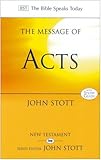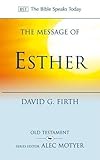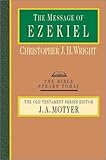
The NIV Application Commentary series takes a unique approach. It contains the full text of the NIV for the passage under commentary, but then deals with it under three headings. First is “original meaning”, which is essentially the material that would be found in a traditional commentary. This seeks to explain the meaning of the text, explaining the historical situation and meaning of words. The second is called “bridging contexts”. This section seeks to build a bridge between the world of the original hearers, and ours, separating what we might call the “timeless” principles or truths, from that which was tied to a specific point in history. Then in the section entitled “contemporary significance” the commentator is given free rein to give contemporary application of one or more of the principles identified in the bridging contexts section. Essentially this section serves as an example of how a preacher might apply the text to a modern congregation.
In a 30 page introduction Jobes outlines some of the unique features of the book of Esther, including its notable lack of reference to God or anything explicitly religious, and the enigma of why some Jews had chosen not to return to Jerusalem at this point. She identifies “reversal of destiny” (or “peripety”) as a key theme of the book, and the providence of God as the main theological lesson. The book of Esther teaches that the Jews still are God’s covenant people, even with no temple, no city and no prophet.
For the most part, Jobes deals with a chapter at a time, although some are broken into smaller chunks. She is cautious in her approach to application, rightly noting the dangers of an “exemplary” approach to hermeneutics (i.e. deciding that everything Esther or Mordecai does is there as a good example for us to follow). Indeed, she shows that there is a good deal of moral ambiguity about their actions, and they may show signs that the Jews in Persia have become secularised to some extent. In any case, the point of the story is not to say whether Esther and Mordecai did right or not, but that God’s covenant purposes were providentially fulfilled through them.
She picks up an idea from Ryken that Esther’s two names suggest a dual identity – she is the king’s wife and a Jew. As the story progresses, these two identities must merge into one. She discusses the challenges of how as Christians we attempt to live within our culture without compromising our values.
As with several other commentators, Jobes shows the link between Mordecai and Haman’s conflict and that of Saul and Agag. She argues persuasively that we are to see the counter-decree as an example of “holy war”. This explains why no plunder was taken, despite it being permitted.
The death of Jesus Christ, the Messiah of Israel, provides the only basis for the cessation of holy war, and the infilling of the Holy Spirit provides the only power by which one may love one’s enemies as oneself
One strength of the bridging contexts sections, is how Jobes always seeks to interpret the events of Esther in the light of the gospel. She never uses allegories or even suggests that the events foreshadow the gospel, but she does nevertheless keep approaching topics in the light of the cross and new covenant.
Much of the discussion relates to “providence”, and Jobes shows how “God works mysteriously, patiently, and inexorably through a series of ‘coincidental’ events and human decisions, even those based on questionable motives and evil intents.” She includes a ten page postscript examining the doctrine of divine providence in a bit more detail.
Her analysis of the structure of Esther is very interesting. She shows how feasts are central to the narrative, and that the book starts with a pair of feasts, has another pair of feasts in the middle and ends with a pair of feasts. This leads her to conclude that the “pivot point” of the book is the king’s sleepless night. In other words, neither Esther nor Mordecai do anything to “turn” events into their favour – it is the providential work of God in a seemingly insignificant occurrence that changes everything. She also shows how the reversal of fortunes of both Haman and Mordecai are arranged in a chiastic structure.
Obviously, the book of Esther brings up various issues relating to women in particular. Jobes does not see this as central to the book’s message, noting that the main adversarial relationship in the book is not between male and female but between the Jews and their enemies. However, she does give some helpful thoughts in the final chapter on male and female partnerships, noting how Esther and Mordecai worked together as “lay leaders” in “secular vocations”. She also emphasises that being a wife or mother on one hand, or being ordained on the other, by no means exhaust the possibilities of vocations, and that much of the debate has been too narrowly focused.
Overall I have to say this is an outstanding contribution to the NIV application series, and I found it very helpful and thought provoking. This is the second of Jobes’ commentaries I have read (the first being her BEC commentary on 1 Peter which was also excellent) and I will be eagerly looking out for any forthcoming volumes from her.












